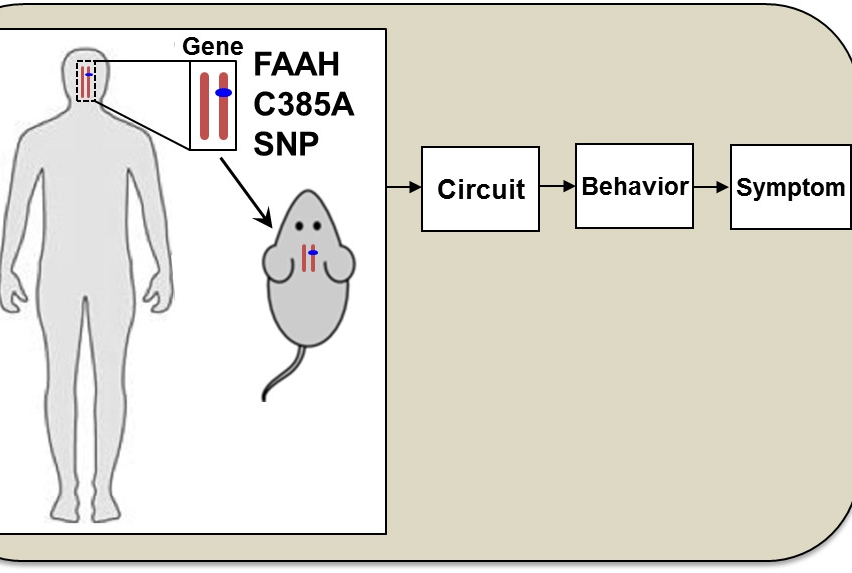
Fear derived from genes
One of my friends' wife is particularly afraid of spiders. Every time she sees a spider, she is on the verge of hysteria until my friend's wife catches the spider and banishes it from the apartment. The lady also dislikes cockroaches, but that's just disgust; only spiders can evoke a truly deep fear within her. However, upon closer examination, there seems to be no particular reason for this fear. There are no poisonous spiders in Beijing, none have been found in her hometown, and she had no traumatic experiences with spiders in her childhood. She describes it this way: "I think this fear comes from my DNA, perhaps my grandmother experienced something terrifying related to spiders, and then she passed it on to me." This explanation is interesting, but I'm afraid most biologists would dismiss the so-called "grandmother inheritance" explanation, as it goes against the central dogma of molecular biology. The central dogma refers to the process where genetic information encoded in DNA is transcribed into RNA, and then translated into proteins, completing the transcription and translation of genetic information. This flow of information is strictly unidirectional. Changes in the sequence of DNA (mutations) can occur, but these are random. Therefore, the explanation that my friend's fear of spiders is inherited from a grandmother who was afraid of spiders is untenable: according to the central dogma, it is impossible for my friend's grandmother to modify her DNA encoding in response to a traumatic spider-related event and pass this fear on to her descendants. So far, no mechanism has been found that can achieve non-random DNA coding mutations.
As early as the 18th century, a viewpoint was proposed—acquired traits are inherited, meaning that people might inherit traits acquired by their ancestors during their lifetime due to environmental influences. This viewpoint was endorsed by the famous French naturalist Jean-Baptiste Lamarck, and is therefore also known as "Lamarckism." This idea was very popular in the 19th century, and even Darwin agreed with it. However, as people gradually understood the mechanisms of inheritance, it was discovered that genetic information is transmitted through DNA-RNA-proteins, making it clear that acquired traits cannot be inherited. There is also a great deal of evidence that such inheritance does not occur. For example, if someone loses a leg in an accident, their children will not be born with one leg missing. Acquired traits (such as a missing leg) do not reverse the information back to DNA to affect the offspring of the individual. The famous evolutionary biologist Richard Dawkins once pointed out that for over 5,000 years, certain religions have practiced circumcision on未成年 males, which involves removing the foreskin before male sexual maturity. Despite the widespread and systematic continuation of circumcision for hundreds of generations, the descendants of these religious followers are still born with foreskins; no one has inherited the acquired traits of their male ancestors over several generations.
Some might object, arguing that the reason the aforementioned acquired traits have not been inherited is that they do not have a selective advantage. Lamarckism specifically refers to beneficial traits. If a person loses a leg in an accident, it is of no benefit for their offspring to be born with one leg missing. In the 1920s, scientists conducted many experiments to verify whether rats could acquire traits with selective advantages. The most famous series of experiments came from the biologist William McDougall at Harvard University. He placed rats in a water tank with two escape routes, one illuminated and the other not. If the rat chose the illuminated escape route, it would receive an electric shock. His metric was the number of trial-and-error attempts the rats needed before learning to use the dark escape route. Quickly learning this task is obviously an advantage for the rats. McDougall trained a batch of rats, then allowed them to mate and breed their offspring, and trained them to continue breeding, a process that lasted for 32 generations, taking a full 15 years. He found that the offspring of the trained rats learned the task faster than their parents, and as the generations increased, the learning speed became faster. The initial 8 generations (1–8) of rats needed an average of 56 attempts to learn the task, while the last 8 generations (25–32) only needed 20 attempts. Afterwards, Agar and his colleagues carried out a similar experiment that lasted 20 years and obtained similar results. However, both independent experiments had a common perplexing result: the learning ability of the untrained control group rats also increased from generation to generation! There is still no good explanation for this surprising result. Some have taken it as evidence for reincarnation theory—that the offspring of both trained and untrained rats equally received the souls of the deceased trained rats. Whatever the explanation for this result, one thing is clear: artificial training did not cause a significant difference. Therefore, Lamarckism and the inheritance of acquired beneficial traits do not hold, and these results instead support the later emerging central dogma.
Based on the above background, a recent article published in the journal Nature Neuroscience reported some shocking findings. Two scientists from Emory University in Atlanta, USA, Kerry Ressler and Brian Dias, studied the effects of acetophenone on mice. This chemical has a special scent, somewhat like the smell of cherries. They exposed male mice to the smell of acetophenone while administering a slight but painful electric shock. The mice quickly associated the smell with pain. In the end, merely the smell of acetophenone was enough to make them shudder. There's nothing particularly special about this. As early as the 1890s, Pavlov discovered that dogs would salivate upon hearing a bell, and people have recognized since then that animals have the ability to associate similar events. However, what is surprising is that the offspring of the trained mice in the Ressler and Dias experiment also exhibited the same fear characteristics. When the smell of acetophenone wafted into their cages, they shuddered out of fear. Naturally, with the experiments of McDougall and Agar in mind, we would want to know: "What about the control group?" The answer is: no reaction. There were two control groups in the experiment, one untreated with the compound and unresponsive to acetophenone; the other treated with a different odor compound. Interestingly, mice that associated another odor with electric shocks had no reaction to acetophenone, indicating that the reaction is highly specific. This is similar to being afraid of spiders but not cockroaches. Even more surprising is that the third generation of mice still inherited the fear response. In addition, offspring conceived through artificial insemination using the sperm of males with a fear response also exhibited the same fear response. Artificial insemination rules out the possibility that male mice somehow transmit the fear information to female mice, who then pass it on to their offspring in some form. Therefore, the "fear of acetophenone" information is encoded in the sperm, and there's nothing in sperm but a bunch of DNA!

This research is significant and also raises a host of questions. In particular: What is the mechanism of this inheritance? How is it possible to break the central dogma in such a dramatic form? The researchers found that some changes occurred in the brains of mice trained to fear this scent, related to the olfactory system. Compared to the control group, the brains of trained mice had a significantly increased number of neurons containing acetophenone-specific olfactory receptors, and the same was true for their offspring. It's not surprising that repeated exposure to a particular odor would cause changes in the receptors that perceive that odor in the brain. What is perplexing is why this trait would be inherited by the offspring. How could this information be transmitted backward to DNA? The authors of the article believe that what may actually be affected is not the sequence of DNA but the "marks" on DNA related to whether a particular gene is transcribed. These "marks" may be produced through DNA methylation, which involves adding a methyl group to cytosine or adenine. The degree of methylation of a particular gene may represent the importance or priority of that gene's transcription. What is already clear is that an increase in cytosine methylation (usually in the promoter region upstream of the gene) reduces gene expression. The key is that this information can be transmitted to DNA without changing the DNA sequence. But is there evidence to support this speculation? In fact, Ressler and Dias found that the sperm of acetophenone-sensitive mice had significantly fewer methylation marks on the acetophenone odor receptor gene than the control group. It is possible that the reduction in these methylation marks suggests that this gene needs to be highly transcribed during development.
However, this explanation still has many problems. First, how exactly does the fear response to a stimulus change the methylation level of the gene related to that stimulus, especially in sperm, is something we know nothing about. Second, assuming that changes in methylation are a way of marking, we still don't know why or how this methylation difference is interpreted as meaning "afraid of acetophenone." For example, why isn't it interpreted as "hey, there are lots of delicious cherries here, you should be very happy to smell this"? If they had another group of mice associate the same smell with pleasure, that would be very interesting. Would this reaction also be inherited by the offspring? Would the same methylation marks be produced? And perhaps the most interesting question is, what would happen if a female mouse from the "fear" group mated with a male mouse from the "pleasure" group? The questions raised by this research certainly outnumber the answers, but the important thing is that it begins to undermine a core law of modern biology. Although we don't yet know how, this study indicates that the central dogma is not as strict as generally believed.

Perhaps my friend is right. Maybe her grandmother really did experience something terrifying related to spiders, and now it's recorded in her DNA—or more accurately, perhaps methylation on her DNA has produced this effect. Will their daughter also harbor the same fear? That's not yet known, but researchers are trying to find out how long the fear of acetophenone will persist in mice. If this really is a factor influencing human behavior, then obviously, our aversions and fears may be determined by a hodgepodge of past experiences, all of which come from long before we were born. We might really be a bundle of fears from the past.